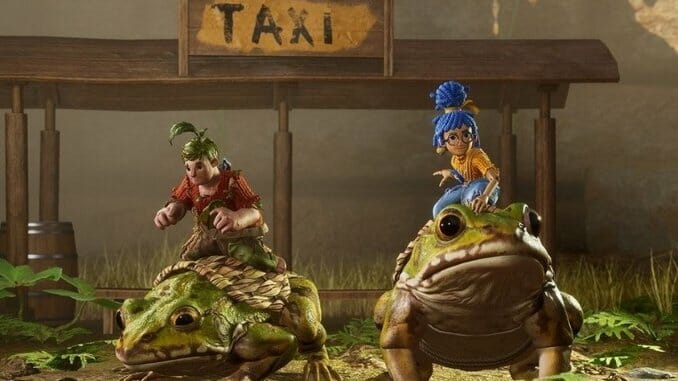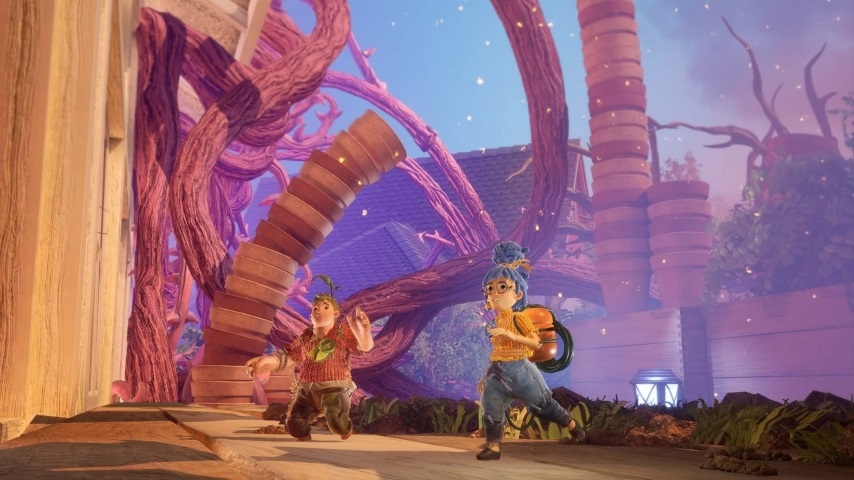It Takes Two Is a Fun, If Disjointed, Examination of What It Means to Be a Partner
It Takes Two isn't always on the same page as itself
Games Reviews It Takes Two
Spoilers for mechanics and light discussion of ending.
The popular saying goes “It takes two to tango,” and it’s absolutely true. It takes commitment to actually make any collaboration work, especially a relationship or marriage, and that’s what drives It Takes Two.
It Takes Two is a cooperative game without a consistent genre. It’s mostly a platformer, but if you’re familiar with the work of its creators, Hazelight Studios, you know they don’t stick to any one thing except cooperation. Or “col-lab-o-ra-tion” as one of the game’s more annoying characters attempts to drill into the player characters and soon-to-be divorcees, May and Cody.
May and Cody are a married couple with a kid who seem to have lost their way. By the opening second of the game, the couple’s already decided on splitting and just need to break the bad news to their daughter Rose, who watches their latest argument from the safety and distance of her top floor window. She holds out two dolls resembling her parents, and you get the sense Rose knows what’s going to happen and regularly retreats to these dolls, through which she fulfills her fantasy of having loving parents.
Eventually, they tell her and she greets the news with a simple “okay” before retreating to a shed with her makeshift parents and crying into a book written by a Dr. Hakim called the Book of Love, all while wishing for her parents to be friends again. From here on out, you play as either of her parents in doll form and work with the guidance of the book (which has now come to life as a terrible “latin lover” stereotype and is never not gyrating or thrusting his hips) to return to their proper bodies. The game then takes you on the wild and shrunken adventures of May and Cody as they flit all over their house and the grounds outside in order to return things to normal and finalize their separation.
The story really just comes across like a flimsy excuse to shrink down our player characters and have them explore imaginative takes on the dullest things, like a clock or a garden. And you know what? It absolutely works for me. Want to play in the tree? Sure, so long as you don’t mind getting wrapped up in a war between the squirrels and wasps Cody never got rid of. Ever wanted to be tiny and play in the castles that your parents bought and built you as a kid? Absolutely, but you have to deal with the fact that Cody never finished the roller coaster tracks leading in and out of it. Really, Cody just needs to get it the hell together.

These mundane settings , bolstered by Rose’s imagination, are an opportunity to get wacky with mechanics and gameplay features, which It Takes Two will just fling at you. Every level explores a gimmick or series of gimmicks almost to the point of tedium before casting it aside for the next, so the game manages to stay remarkably fresh almost the entire way through. One second you’re playing a shooter and the next you may be playing a hack and slash. I don’t want to spoil my absolute favorite, but the amount of ludicrous things that come together to make it happen is nothing short of magic. Little of it makes any sense with or without context, but also It Takes Two comes across as a videogame for the sake of being a videogame, and while I respect that, it does mean the game shoots its own story in the foot often. The game’s simultaneously asking you to care about this impending divorce and the effect it’ll have on their daughter and the ludicrous task to gun down wasps or murdering plushies often! It forces the player to either try and reconcile these nonsensical aspects, or focus on a thing at a time. By the time I reached anything I’ve mentioned, I’d long since shut off my brain and decided to bask in the vibes rather than the story. “Head empty, no thoughts” is the perfect way to enjoy It Takes Two, because otherwise it makes zero sense.
There are occasional hitches, and at least one or two areas that drag a bit, but the rest is terribly fun because Hazelight’s commitment to cooperative gameplay shines through. There is a kind of cooperation in games where the sheer number of players makes the game enjoyable, and then there is what Hazelight does. It Takes Two is joyous and collaborative in ways that constantly had me and my co-op partner say “Man, this is pretty cool” aloud. A snow level not only introduces skating as a mode of movement, but also magnets, which help propel you to platforms and pull you towards each other, for example. Or maybe your weapons in one level will interact with one another to clear obstacles, or you’ll just have different abilities that intersect in ways you didn’t imagine on a gravity-defying course.
My favorite of these gimmicks stemmed from a fight the couple had, where Cody expressed how he wished he had more time with May and she wished she could be in two places at once to give that to him. In order to help them reconcile these issues, Dr. Hakim gives Cody the ability to manipulate time and May the ability to clone herself in a particular space and warp to it. I won’t spoil the ins and outs of the puzzles, but they’re solid and rewarding to figure out as they push further and further outside their established rules. It feels especially good to make sense of the puzzles in the company of a friend who’s constantly telling you what a big brain you have when you figure it out. And don’t worry, I said it right back to him when he solved puzzles too.
Again this is where the game shines; in the dance between players. Where it’s less sterling is where its idiom-turned-title intertwines with the narrative. It Takes Two’s story (and the characters’ daughter) rightfully believes that a relationship is work. The problem, or at least where there’s a disconnect, is that the work never really happens all the way to the ending. For the majority of the 10-12 hours you’ll spend with Cody and May, you get the sense that their problems aren’t just the circumstances that landed them at the point of divorce, like time away from family because of work, but a more fundamental incompatibility and unwillingness to cooperate until the game forces them to. It isn’t until late in the game that our two protagonists are even really positioned as being on the same page or having something resembling a warm history, because their current relationship is mired in jabs and a desire to cut and run.
I think I see the warmth of Cody and May’s past peering out from under the ruins of their relationship, the little time and attention paid to fostering that makes where the story ultimately lands feel insincere. The platitudes the game walks out to “solve” the problems of their relationship feel earnest, but ring tired and ultimately unrealistic. The “work” that they do is just one big action-packed vacation. It’s jumping around on frogs, beefing with squirrels and one really odd and concerning point that I won’t ruin here. Rest assured, couple’s therapy and genuine understanding this is not. I’m happy to play the couple as they rediscover the magic of their relationship, but it’s not just fun that mends such deep divides, even if writer Josef Fares seems to really think so. It may take two to tango and two to make a (non-poly) relationship work, but it also takes two people wanting to make it work for it to happen. So while there’s a broad sweetness to be found in some later levels and in the spare line here or there, the relationship’s intricacies and history are so unexplored and formless I don’t know that I can buy in on it and it’s conclusion.
While this bothers me, and may bother people looking for some deeper exploration of marriage, love, attraction and the difficulties that abound in all of that mess, It Takes Two doesn’t strike me as the place to go looking for it. It really doesn’t even strike me as all that interested in its own premise outside of set dressing. The game’s story definitely tries to contextualize its setpieces, mechanics and shifting tones, but the disparate aspects of the game could not feel more divorced from each other, making them easy to enjoy and critique apart, but also similarly easy to slam for their ultimate incompatibility as a whole. I’m not crazy about the story, but it’s serviceable and has big “R-Rated Pixar” energy, mostly being a vehicle for the thrill of actually playing the game with a friend. Maybe that’s all It Takes Two has to be and, honestly, that’s fine by me.
It Takes Two was developed by Hazelight Studios and published by Electronic Arts. Our review is based on the Xbox Series X version. It’s also available for PlayStation 4, PlayStation 5, Xbox One, and PC.
Moises Taveras is an intern for Paste Magazine and the managing editor of his college newspaper, the Brooklyn College Vanguard. He was that one kid who was really excited about Google+ and is still sad about how that turned out.